In this episode, we team up with taxidermist Allis Markham to recreate the Monstrous Sea Pig, one of the creatures found on Olaus Magnus’ “Carta Marina” of 1539 — the world’s most famous sea-monster map.
NOTES & REFERENCES
I’ve just started compiling all the notes for this video. What is here is incomplete and definitely a bit of a jumble. But check back soon!
The Island of Thule (0:00-0:11)
We’ll add detail to the story as we go along, but the Monstrous Sea Pig’s meteoric rise to sea-monster stardom is due to its inclusion on the most famous sea-monster map of them all — Olaus Magnus’ Carta Marina from 1539. As Olaus makes explicit in the book he wrote to accompany the map — the massive and thoroughly entertaining Historia de gentibus septentrionalibus (History of the Northern Peoples, 1555) — the Monstrous Sea Pig was spotted off the coast of Germany (the same place that also happened to produce a certain schismatic monk named Luther — more on this later). But for whatever reason, most likely to use the space on the map efficiently, the map’s illustrator located the Monstrous Sea Pig near the island of Thule. This sea-pig-Thule association was regarded as vital lore by subsequent commentators who enjoyed the map but who, evidently, just couldn’t find the time to read the accompanying book. Accordingly, it is on Thule that we begin our own retelling of the sea-pig story.
Illustration of the island of Thule (here Latinized as TILE), adapted from the “Carta Marina” of Olaus Magnus, 1539. Colorized and given depth by AB, Dec. 2012. The text reads “HEC INSVLA HABET XXX MILLIA POPV: ET AMPLIVS” (This island has 30 thousand people and more) and “HIC HABITAT DÑS INSVLA℞” (Here dwelleth the island Lord).
The island of Thule (“a six day’s sail north from Britain” [Strabo 1.4.2]) is a legendary island in the North Sea that first entered traveler’s tales in ancient Greek times. The earliest description of this mythical isle comes to us, in an appropriately convoluted fashion, from Strabo’s reporting (ca. 20 CE) of Polybius’ assessment (ca. 100 BC) of a lost first-hand account by an explorer (and “arch-falsifier” [Strabo 1.4.3]) named Pytheas (ca. 300 BC):
πολύβιος δὲ τὴν Εὐρώπην χωρογραφῶν τοὺς μὲν ἀρχαίους ἐᾶν φησι, τοὺς δ᾽ ἐκείνους ἐλέγχοντας ἐξετάζειν Δικαίαρχόν τε καὶ Ἐρατοσθένη τὸν τελευταῖον πραγματευσάμενον περὶ γεωγραφίας, καὶ Πυθέαν, ὑφ᾽ οὗ παρακρουσθῆναι πολλούς, ὅλην μὲν τὴν Βρεττανικὴν ἐμβαδὸν ἐπελθεῖν φάσκοντος, τὴν δὲ περίμετρον πλειόνων ἢ τεττάρων μυριάδων ἀποδόντος τῆς νήσου, προσιστορήσαντος δὲ καὶ τὰ περὶ τῆς Θούλης καὶ τῶν τόπων ἐκείνων, ἐν οἷς οὔτε γῆ καθ᾽ αὑτὴν ὑπῆρχεν ἔτι οὔτε θάλαττα οὔτ᾽ ἀήρ, ἀλλὰ σύγκριμά τι ἐκ τούτων πλεύμονι θαλαττίῳ ἐοικός, ἐν ᾧ φησι τὴν γῆν καὶ τὴν θάλατταν αἰωρεῖσθαι καὶ τὰ σύμπαντα, καὶ τοῦτον ὡς ἂν δεσμὸν εἶναι τῶν ὅλων, μήτε πορευτὸν μήτε πλωτὸν ὑπάρχοντα: τὸ μὲν οὖν τῷ πλεύμονι ἐοικὸς αὐτὸς ἑωρακέναι, τἆλλα δὲ λέγειν ἐξ ἀκοῆς. ταῦτα μὲν τὰ τοῦ Πυθέου, καὶ διότι ἐπανελθὼν ἐνθένδε πᾶσαν ἐπέλθοι τὴν παρωκεανῖτιν τῆς Εὐρώπης ἀπὸ Γαδείρων ἕως Τανάιδος.
STRABO, Geographica, 2.4.1.
“Polybius, in his Chorography of Europe, tells us that it is not his intention to examine the writings of the ancient geographers, but the statements of those who have criticised them, such as Dicæarchus, Eratosthenes, (who was the last of those who [in his time] had laboured on geography) and Pytheas, by whom many have been deceived. It is this last writer who states that he travelled all over Britain on foot, and that the island is above 40,000 stadia in circumference. It is likewise he who describes Thule and other neighbouring places, where, according to him, neither earth, water, nor air exist, separately, but a sort of concretion of all these, resembling marine sponge, in which the earth, the sea, and all things were suspended, thus forming, as it were, a link to unite the whole together. It can neither be travelled over nor sailed through. As for the substance, he affirms that he has beheld it with his own eyes; the rest, he reports on the authority of others. So much for the statements of Pytheas, who tells us, besides, that after he had returned thence, he traversed the whole coasts of Europe from Gades to the Don.”
STRABO, Geographica, 2.4.1. (trans. HAMILTON, H.C. and FALCONER, W.)
What’s remarkable in this account, and what seems to have been dropped from subsequent Thule-lore, is that Thule is described as having the consistency of a πλεύμων θαλάττιος, a “sea-lung”, translated above as a “marine-sponge” but in Liddel and Scott as a jellyfish.
HAECKEL, Ernst. “Chrysaora mediterranea”, lithograph, 1899. From Kunstformen der Natur, Volume 1, Table 8 “Desmonema: Discomedusae — Scheibenquallen”, Verlag des Bibliographischen Instituts, Leipzig und Wien, 1904. Digitized photographic reproduction of the complete text provided by the Universitätsbibliothek Heidelberg. Image captured and given a transparent background by AB, 21 nov. 2014.
Thule can count some other conspicuous cameos in the classical canon, including Pliny, Naturalis Historia (2.78, 4.41, 6.72), Procopius, De Bellis 6.15, and most famously Vergil’s Georgics 1.30 which contains the catchy dactyl-spondee pair “ultima Thule” (read as 5 syllables: — ∪ ∪ — — ).
Olaus Magnus and the Island of Thule
Olaus Magnus (1490-1557) [his surname is a Romanization of Månsson] was a Swedish Catholic cleric who had the misfortune of watching his native land be converted to Lutheranism under the Swedish king Gustav Vasa. Olaus ultimately sought exile in Rome where both his brother, Johannes, and then Olaus himself were named archbishop of Uppsala, which was (and still is) the highest church office in Sweden. Neither brother actually served in that position, however, since recent events had reduced the archbishopric to a mere “titular see”. Both Magnus brothers spent their days in exile writing scholarly tomes about Sweden and Scandinavia, partly the result of their Swedish patriotism, but also undoubtedly to raise the profile of Sweden amongst the Catholic hierarchy who did not appear to be overly exercised at the prospect of losing the Scandinavian kingdoms to the Lutherans. Olaus in his writings comes across as particularly bitter that Sweden’s long-desired independence from the Danes (more precisely, the Kalmar Union) was accomplished by a king, Gustav Vasa, who found it likewise desirable to seek independence from the Catholic church. A more complete account of Olaus and his times can be found in the introduction to the Hakluyt Society’s English translation of Olaus Magnus’ Description of the Northern Peoples.
As mentioned earlier, the Monstrous Sea Pig, which was reported to have been sighted off of the coast of Germany, has nothing whatsoever to do with the island of Thule; it’s only because the sea pig and Thule are located next to each other on the Carta Marina that this connection was made by subsequent seapigologists. All the same, it’s interesting to examine Olaus’ thoughts on Thule since 1.) he is his era’s most comprehensive source of information on Scandinavia and 2.) his accounts of Thule are exceedingly confusing. First, let’s introduce the 4 works we have from Olaus that together constitute something of a tetralogy of Swedish ethnography:
| Olaus Magnus’ Four Swedish Pieces |
1. Carta marina et descriptio septemptionalium terrarum ac mirabilium rerum in eis contentarum diligentissime elaborata, Giovanni Tommaso [?], Venice, 1539. Digitized photographic reproduction of the Uppsala orginal (one of only two original maps) provided by Uppsala University archives and libraries virtual image network (ALVIN). |
2. Opera breve la quale demonstra e dechiara, overo da il modo facile de intendere la charta, over delle terre frigidissime di Settentrione, Giovanni Tommaso, Venice, 1539. Digitized photographic reproduction of the complete text provided by Google Books. |
3. Ain kurze Auslegung und Verklerung der neuuen Mappen von den alten Gœttenreich und andern Nordlenden, Giovanni Tommaso [?], Venice, 1539. Digitized photographic reproduction of the complete text provided by Google Books. |
4. Historia de gentibus septentrionalibus, Giovanni Maria Viotti, Rome, 1555. Digitized photographic reproduction of the complete text provided by Google Books. |
Note: A similar, but more comprehensive list of references is provided below in our Chronological Bibliography. |
The first of these works is the famous Carta Marina which was, at the time, the most detailed map of Scandinavia ever produced and would surely still win the prize for best cartographical sea-monsters if such a prize were awarded (wait—maybe it should be!). The map, whose full title translates to Maritime Chart and Description of the Northern Lands and the Wondrous Things Contained Therein, Assiduously Wrought in the Year of Our Lord 1539, at Venice, through the Liberality of the most Reverend Lord Girolamo Quirino, Patriarch of Venice, is huge, measuring nearly 6 feet wide by 4 feet tall. It was printed as 9 separate woodblocks with the island of Thule (and the monstrous sea-pig) appearing in woodblock D. There are only two original copies of the map known to exist: one, discovered in 1886 and now at the Bayerische StaatsBibliothek in Munich, and a second, not discovered until 1961, that now resides at the University of Uppsala in Sweden where the digitized photographic reproduction of the map that we have used is hosted. At the lower left corner of the map, at the bottom of the key, one can read, “Venundantur in Apotheca Thome de Rubis in corona super ripam ferri prope Pontem riui alti Venetiis,” which translates to, “To be sold at the shop of Thomas de Rubis, at the Crown, on the Riva del Ferro near the Rialto Bridge, Venice.” I’m not entirely sure what corona refers to, if indeed it is the shop’s name (“The Crown”, as I’ve translated it) or rather some other descriptive, but certainly the Riva del Ferro (“Iron Wharf”) and Rialto Bridge are still landmarks in Venice such that one can almost pinpoint the shop’s location on a modern map.
The next two works, the Opera breve [“Short Work” (Italian)] and the Ain kurze Auslegung [“A Brief Outline” (German)] are short pamphlets (both are about 15 pages) produced to accompany the map. Curiously, and surely informative of the intended recipients of the map, one pamphlet is in Italian and the other is in German; neither is in Latin (as is the map itself) nor Swedish. The Opera breve indicates that it was published in Venice in 1539 by Giovan Thomaso “from the Kingdom of Naples”; I can’t find explicit information as to who printed the kurze Auslegung or even the Carta Marina, but it seems exceedingly likely that all were printed by this same Signor Thomaso, particularly since all three documents indicate that they were printed in Venice in 1539. On can find this assertion maintained in at least one modern publication. The edition of the Ain kurze Auslegung that can be found on google books (and which belongs to the Austrian National Library) is a real treasure since the printed woodcuts (there are two) were subsequently painted in beautiful colors. This one is particularly charming:
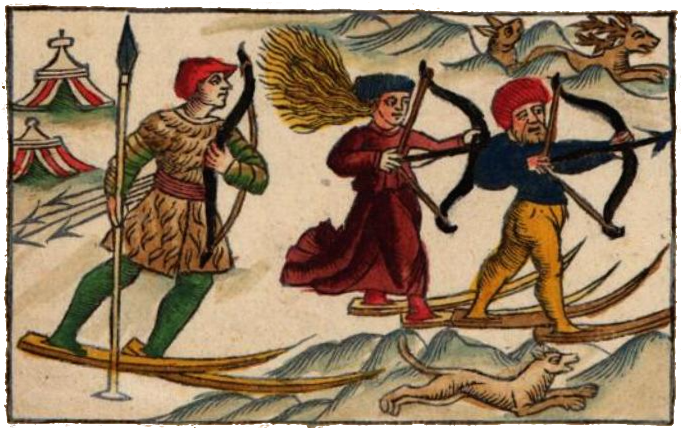 UNKNOWN ARTIST. “Male and Female Hunters on Skis”, painted woodcut, 1539. From Ain kurze Auslegung und Verklerung der neuuen Mappen von den alten Gœttenreich und andern Nordlenden, Giovan Thomaso [?], Venice, 1539, p. 14. Digitized photographic reproduction of the complete text (from the collections of the Austrian National Library) provided by google books. Image captured and given a transparent background by AB, 6 mar. 2015. The accompanying caption reads, “Alſo iagen die men̄er und etliche uueyber auf dē Schne uie hie ſtat.” [“Thus do the men, and quite a few women, hunt upon the snow as shown here.”] The identical woodcut is used at the top of Book 1, chapter 5 of the Historia de gentibus septentrionalibus (1555) and a nearly identical woodcut appears in the Carta Marina, woodblock B, as one of illustrations for the region of “Finmarchia”, that is, Finnmark. Given the rather unusual subject matter, I think it’s safe to declare that this is, at the very least, the world’s oldest color illustration of a woman skiing (indeed, it turns out there are quite ancient depictions of men on skis).
UNKNOWN ARTIST. “Male and Female Hunters on Skis”, painted woodcut, 1539. From Ain kurze Auslegung und Verklerung der neuuen Mappen von den alten Gœttenreich und andern Nordlenden, Giovan Thomaso [?], Venice, 1539, p. 14. Digitized photographic reproduction of the complete text (from the collections of the Austrian National Library) provided by google books. Image captured and given a transparent background by AB, 6 mar. 2015. The accompanying caption reads, “Alſo iagen die men̄er und etliche uueyber auf dē Schne uie hie ſtat.” [“Thus do the men, and quite a few women, hunt upon the snow as shown here.”] The identical woodcut is used at the top of Book 1, chapter 5 of the Historia de gentibus septentrionalibus (1555) and a nearly identical woodcut appears in the Carta Marina, woodblock B, as one of illustrations for the region of “Finmarchia”, that is, Finnmark. Given the rather unusual subject matter, I think it’s safe to declare that this is, at the very least, the world’s oldest color illustration of a woman skiing (indeed, it turns out there are quite ancient depictions of men on skis).
Whereas the Opera breve and Ain kurze Auslegung are meant to be short guides to the Carta Marina, the fourth of Olaus Magnus’ works on our list, the Historia de gentibus septentrionalibus, is a massive 800-page Latin tome about the people, places, customs, animals and, of course, sea-monsters of Scandinavia. The Historia, which was published in 1555 — a solid 15 years after the Carta — refers repeatedly to the Carta and illustrates each chapter with woodcuts that are identical to, or slightly modified from, those found on the map. Since the Historia contains no shortage of text, it is here that we might expect to find the most detailed explication of the mysterious island of Thule. Surprisingly, though, the Historia contains essentially zero information about Thule. In fact, a careful search through the book turned up only two references to the island which I include here for completeness:
“Prætereà Plinius lib. II. cap. LXXVII. de longiſsimo, ac breuiſsimo die mentionem faciens, tradit in Britannia diem eſſe XVII. horarum, vbi æſtate lucidæ noctes haud dubiè repromittant id, quod cogit ratio credi, ſolsſtitialibus diebus accedente ſole propius verticem mūdi, anguſto lucis ambitu ſubiecto1 terræ continuous dies haberi ſenis menſibus, noctesque ecōtrà ad brumam remoto: quod fit in Tyle ſex dierum nauigatione verſus Septentrionem à Britannia diſtante.”
1. Modern editions have subiecta … habere.
“Moreover Pliny, in Book II chapter 77, when making mention of the longest and shortest days, relates that in Britain a day can be 17 hours long. There, during the summer, the bright nights doubtless guarantee that which reason compels us to believe, namely, that on solstice days when the sun comes close to the earth’s pole and the orbit of its light is contracted, the underlying regions of earth have continuous daylight for six months and, contrariwise, six months of night when the sun has withdrawn to its nadir. This happens in Thule, lying a six days’ sail north from Britain.”
MAGNUS, Olaus. Historia de gentibus septentrionalibus, 1:5, Rome, 1555.
“Pro declaratione præſentis capitis, aduertendum erit, quod Islandia terra eſt ſubiecta polo Arctico, vēnto prȩsertim Circio oppoſita, ac mari Glaciali propinqua: atque ob id dici meretur terra glacialis, ſeu vltimum Tyle1, nulli veterum non celebrata…”
1. A neutered and Germanicized rendering of Vergil’s ultima Thule.
“To clarify the present chapter, it will be noted that Iceland is a land lying beneath the Arctic Pole, exposed especially to the wind Circius, and near the Ice Sea. And on account of this it merits being called Ice Land, or remotest Thule, which none of the ancients fails to repeat…”
MAGNUS, Olaus. Historia de gentibus septentrionalibus, 2:3, Rome, 1555.
Was Thule Believed to be Iceland?
This last passage suggests that Olaus believed the legendary island of Thule was actually the very real island of Iceland. Indeed, the index of places in the Hakluyt Society’s modern translation of Olaus’ Historia has the rather peremptory entry: “Thule, see Iceland.” But we know this can’t be the full story since, most glaringly, the Carta Marina depicts Thule and Iceland as two entirely distinct islands. Surprisingly, it is in the Opera breve and Ain kurze Auslegung that we find Olaus’ most detailed account of the matter. Not only are the descriptions exceedingly confusing, but there are significant nuances between the Italian and German pamphlets which is moderately unfortunate since I cannot claim to be a master of 16th century German. All the same, I think that with patience I was able to untangle this mess and construct a satisfactory account of what Olaus is trying to say. Altogether there are two passages in each of the two pamphlets (for a total of four) which, for completeness, we include below:
“Alcuni chiamano questa isola, Tyle, & alcuni uoleno che sia Islanda: ma io ritrouo Procopio piu ueramente hauere descritta l’Isola Scandiana sotto il nome di Tyle: non dimeno e in questa Tyle la habitatione del presidente delle Orchade, & ha questa Isola circa trenta millia huomeni che la habitano, li quali non uorebbeno mutare la loro sorte con la felicita dell’altre regione.”
“Some call this island Thule and others insist that it’s Iceland; I find that Procopius has, under the name of Thule, more accurately described the island of Scandia. Nonetheless, it is on this Thule where the habitation of the president of the Orkneys is. This island has some thirty thousand people who inhabit it and and who would not wish to exchange their lot for the happiness of other regions.”
MAGNUS, Olaus. Opera breve, section D.F, Venice, 1539.
“Etliche hayſē diſe Inſele Tile etlich sagen das Island iſt Tile ich aber vermerck das Procopius hat die groſſen Scandianen vnder dem namen Tile (auſs vnuerfarenhait) beſchreybung vvie hindenanzaigt. Doch vvonet auf diſe Tile der herr von den Inſelen Orcades genandt vnnd hat. 2. groſſe ſchlœſſer und. XXX.M. inuoner vnder ſeinem gepiet die ihrem glück vnd volfart nit veruuandel vvelen mit anderm volck.”
“Some call this island Thule, some say that Iceland is Thule, but I note that Procopius gives (out of inexperience) a description of greater Scandia under the name of Thule as indicated below. Nonetheless, there dwells on this Thule the lord of the islands called the Orkneys and he has 2 large palaces and 30 thousand inhabitants under his dominion who would not exchange their fortune and welfare with other people.”
MAGNUS, Olaus. Ain kurze Auslegung, section D.F, Venice, 1539.
Of course, tricky translations of this sort seem simple once they fall into place, but the key was to not translate Scandiana / Scandianen as “Scandinavian” (which, in an early-modern context would be perfectly correct) but rather to keep the reference to Scandia, the classical name for the Scandinavian mainland which was traditionally believed to be an island. And, of course, it was necessary to dig up the Procopius reference (viz., De Bellis VI.15); but more on that later. As Olaus hinted above in Ain kurze Auslegung (but not the Opera breve) there is additional information hiding elsewhere in these pamphlets:
“[Scandia] e il nome dell’ampliſſima Iſola, o peninſula Scandiana, dalla quale gia potentiſſimi populi ſcorſono nel’uniuerſo mondo: & e dal Plinio nel libro. 4. cap. 13. chiamata unaltro mondo per la incomprehenſibile grandezza, & da Procopio deſcritta ſott’il nome di Tyle: et ſi dice diece uolte magiore di tutta Bertagna, & tredici nationi, & regni contenere in ſe, & abondare di copioſiſſima moltitudine di mortali.”
“[Scandia] is the name of the largest Scandinavian island or peninsula, out of which the most powerful peoples in the whole world once emerged. And it is by Pliny in Book 4 chapter 13 called another world for its incomprehensible size. And it is described by Procopius under the name of Thule and said be ten times larger than all of Britain and to contain thirteen nations and kingdoms within itself and to overflow with a copious multitude of people.”
MAGNUS, Olaus. Opera breve, section E.A, Venice, 1539.
“[Scandia:] der nam der groſſen inſel Scandiana bey den alten un neuuen Hyſtorien genant uon uelchier inſel uor langer zeyt die Gotten urſpruncklich in kriegsueiſs auſsgangen ſein in die uuelt uon der groſſen inſel schreibt Pliniꝰ lib. 4. ca. 13. Vnd ſagt das Scandiana die ander uelt umb ſeiner unerfaren groſshait uirdt geacht. Der Procopius under dem namen Tile (docr ſolt liber gesagt habē Tilemarchia das in Noruegen ligt uirdt in Scandia begriffen) beſchreibt ganz klerlich und ſagt diſs landt ſey uuol zehē mal groſſer dann des ganz Britania und hat 13 landschaft un̄ fül Künigreich un̄ über auſs uil uolck.”
“[Scandia:] the name for the large Scandinavian island used by historians new and old, from which island a long time ago the Goths are to have originally set out in a warlike way into the world from the large island as Pliny writes in Book 4 chapter 13. And he says that Scandinavia is considered another world from its unusual magnitude. Procopius, under the name of Thule (although the book should have said Telemark which lies in Norway [and] is understood as Scandia) describes very clearly and says this land is a full ten times bigger than all of Britain and has 13 territories and full kingdoms and exceedingly many people.”
MAGNUS, Olaus. Ain kurze Auslegung, section E.A, Venice, 1539.
The illustration on the “Carta Marina” to which these passages refer is the word SCANDIA in large text (the largest on the entire map, in fact) appearing in the center of the map, in woodblock E, letter A, over the Swedish mainland, and reproduced below:
 MAGNUS, Olaus. “Carta Marina”, Venice, 1539. Detail of woodblock “E”. The text reads, “SCANDIA. PENINSVLA QVAM PLINIVS LI:4:CA:13: ALTERUM ORBEM VOCAT. PROCOPIVS SVB NOMINE TVLE ASSERIT DECIES MAIOREM TOTA BRITANNIA ET XIII REGNA IN SE CONTINERE.” This translates to, “Scandia: the peninsula which Pliny in Book 4 chapter 13 calls another world. Procopius asserts it is ten times larger than all of Britain and contains 13 kingdoms.”
MAGNUS, Olaus. “Carta Marina”, Venice, 1539. Detail of woodblock “E”. The text reads, “SCANDIA. PENINSVLA QVAM PLINIVS LI:4:CA:13: ALTERUM ORBEM VOCAT. PROCOPIVS SVB NOMINE TVLE ASSERIT DECIES MAIOREM TOTA BRITANNIA ET XIII REGNA IN SE CONTINERE.” This translates to, “Scandia: the peninsula which Pliny in Book 4 chapter 13 calls another world. Procopius asserts it is ten times larger than all of Britain and contains 13 kingdoms.”
Is Thule Actually Telemark, Norway?
The claim made by Olaus above in Ain kurze Auslegung (but not the Opera breve nor the “Carta Marina”) is exceptionally intriguing: Olaus asserts that (1.) Procopius’ description of Thule (De Bellis 6.15) is best understood as applying to the Scandinavian mainland as opposed to a small island (this, indeed, is the universally accepted reading of this Procopius passage) and (2.) in addition, Procopius was probably referring to Telemark in Norway. This little offhand comment of Olaus’ is stunning because, when one thinks about it, the connection between Thule and Telemark is so obvious. For one thing, their Latin names on the “Carta Marina” are glaringly identical: TILE (Thule) and TILEMARCHIA (Telemark). Given that “Marchia” is a generic suffix meaning border-land (cf. Denmark, etc.) and given that in nearly every language except English “Thule” has two syllables, Telemark might as well be named “Thule-Mark”.
Of course, I’m hardly the first post-Olaus Thulephile to make the connection between Thule and Telemark, but considering the general fascination with Thule, I’m surprised this association isn’t better known or, for that matter, promoted by the Telemark tourism office. Indeed, the whole story coheres together in a rather satisfying way since Telemark (and the Scandinavain mainland in general), being some several hundred nautical miles distant from Britain, would indeed require about a six days’s sail to the north in a vessel making a few knots. Thus we can easily imagine that the Scandinavian mainland, which was long supposed to be an island, was called Thule by the first Greek speaking visitors there due to their encounters with the ancient tribes of Telemark. Later, as “Scandia” became the accepted term for the Scandinavian mainland/island used by classical geographers, the location of Thule became unclear, hence its banishment to the far, sea-monster infested corners of old maps.
Appalachian Thule
Finding a suitably Thule-ish location to film the opening sequence of this episode was a bit of a challenge in that I live in Washington, DC, and sadly this little hobby of mine doesn’t have an international travel budget. The place I did find has something of a mythical quality in its own right, though, since an exceedingly rare combination of circumstances have conspired to create a warm lake on a very cold mountain which together generate an insane amount of vapor and wind. I won’t name the precise spot, since I’d prefer to preserve some of its mystery, but I quite nearly didn’t make it home since my car got stuck in the snow and my phone had zero reception. Yes, this situation could have gotten very bad very quickly, but let’s just say my guardian sea-pig was watching over me that day.
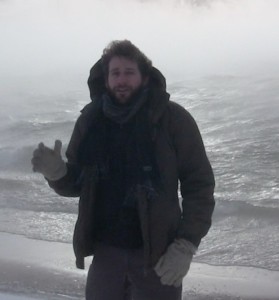 Me, at the closest approximation I could find to the Island of Thule, 17 feb 2013. This video-still (and the rest of the video) was taken by my very good friend and Wunderkammer-accomplice, Mr. Thomas A. Brady.
Me, at the closest approximation I could find to the Island of Thule, 17 feb 2013. This video-still (and the rest of the video) was taken by my very good friend and Wunderkammer-accomplice, Mr. Thomas A. Brady.
EVOLUTION OF THE MONSTROUS SEA-PIG
Source 1: A Pamphlet by Antonio Blado, Rome, 1537
The translation I made below is, to the best of my knowledge, the very first translation into any language of this fascinating little pamphlet. We have also, through the simple act of actually reading the text, uncovered the author of this supposedly “anonymous” work. It is none other than Antonio Blado himself, as he make perfectly clear in the pamphlet’s heading!
Monstrum in Oceano
Germanico a piscatoribus nuper captum,
& eius partium omnium subtilis,
ac Theolgica interpretatio.
Hieremiæ cap. I.
Ab Aquilone pādetur malum super
omnes habitatores terræ.
Idē cap. IIII.
Malum ego adduco ab Aquilone.
ANTONIVS
BLADVS TYPOGRA
phus Pio Lectori S. D.
Quod mihi nuper ex Germania allatū est optime Lector seu monstrum, seu naturæ collusio, uel quicquid sit id tibi nō solum pictum ostēdere, uerum etiam ex doctorum sacrorum authoritate inerpretari uolui. In Oceano aiunt repertū fuisse Germanico, in qua ora etiā uersant mōstra quam plurima, fidei & relgionis Christianæ quæ nouas sibi leges, & si Diis placet, nouos etiam Deos confinxerunt. Accipe itaque aquaticum hoc portentum, & quid quælibet pars eius portendat, diligenter inquire. Vidisti caput Porcinū: per Porcum ueritatis contemptor significatur, ut habetur Mathei capit VII. Neque mittatis margaritas uestras ante porcos: quod intelligitur, nolite communicare cum hæreticis ea quæ ipsi spernunt, scilicet ueritatem. Vidisti Lunā in occipte Porci: per Lunam significatur ecclesia universalis quemadmodum per stellas fideles, ut habetur apud Paulum ad Philipenses cap. II. Inter quos lucetis sicut luminaria in mundo: ecclesiæ ergo ueritas non est in fronte iniquis hæreticis, sed in occipite porci, id est contemptorum hominum, hoc est post habetur ueritas, & amatur mēdacium. Vidisti duos oculos in lumbis, tertius in uentre: per oculos interpretantur doctores, & præcipue Hier. super Mat. cap. V. cogitationes, & sensus. Inquit enim quod si oculus tuus scādalizat te, erue eum. Quia supra de cōcupiscentia mulieris dixerat, recte tunc cogitationem & sensum in diuersam voluntatem, oculum nuncupauit:1 per tres igitur oculos quid aliud significari possit, quam cogitationes, & sensus carnalium uoluptatum, quæ in lumbis continētur? In uentre autem quid præter gulam, & crapulam significetur non uideo, ut in eis uerificetur illud Pauli. quorum Deus uenter est: ibi enim per uentrem tam ganea quam carnalia desyderia significantur. Vidisti quatuor pedes draconis: Per pedes operationes mortalium significantur. Hier. enim exponens illud Apostolicum ad Epheseos cap. VI. Et calciati pedes in præparatione euangelii pacis. Diligentius inquit obseruate quod uirtute quadā animæ appelauit pedes quibus ingredimur, in eo qui dicit ego sum uia, & quos nos oportet calceare in præparatione euāngelii pacis. Per Draconem præterea malitiosum ritum, vel diabolum insidiantem significari voluerunt, & præcipue Grego. exponens illud Iob cap. XXX. Frater fui draconum &c. Draconum inquit nomine malitiosorum hominum uita significatur: & Augustinus exponens illud Dauidicū, Et conculcabis leonem, & draconē, inquit Leo dicitur diabolus, dum persequitur innocentes: draco cum negligentes impia uoracitate deglutit: quatuor ergo pedes draconis, quid aliud significare possint, quam quod diabolicæ operationes huismodi hæresis insidiatur nobis a quatuor cardinibus mundi? Hæc omnia sunt in pisce, & per pisces curiosos huis seculi accipere debemus, si credimus doctoribus exponentibus Psalmum VIII. Volucres cœli & pisces maris &c. Per uolucres enī cœli sublimia sapientes, per pisces maris, qui in magnis rerum inquisitionibus, quasi in abditis fluctibus latent, intelligunt. Habes itaque pie Lector quid caput Porcinum, quid Luna in eius occipite, quid quatuor pedes draconis, quid oculi in lumbis, & in uentre, quid præterea piscis sibi uelint. Tu ut pius es, quid omnia hæc simul iuncta portendant, pro pietate tua, ac religione interpretabere: uolui enim unicuique integrū esse quid Spiritus Sanctus in eo luminis afferret. Vale Romæ Idibus
Octob. M. D. XXXVII.
1. Sic. Jerome’s commentary reads, “…recte nunc cogitationem & sensum in diuersa volitantem, oculum nuncupauit.”
Monster in the North Sea
Recently Caught by Fishermen:
A subtle and theological interpetation
of all of its parts.
Jeremiah Ch. I.
“Out of the North an evil shall break forth upon all the inhabitants of the land”
The Same, Ch. IIII.
“I will bring evil from the North”
ANTONIO
BLADO, PRINTER,
To the Pious Reader, Health.
What was recently reported to me from Germany, good reader, be it monster or freak of nature, whatever it is I wanted not only to offer you an illustration but also to interpret it according to the authority of our sacred teachers.1 They say it was found in the German Sea [i.e., the North Sea], along which shore there also roam very many monsters which have devised for themselves new laws of the Christian faith and religion and, if it please the Gods, new Gods as well. Take, then, this aquatic portent and diligently inquire what each of its parts portends. You have seen its swinish head; by a pig, the scorner of truth is signified, as in chapter 7 of Matthew, “neither cast ye your pearls before swine.” By this is understood, do not share with heretics that which they spurn, namely, the truth. You have seen the moon on the back of the head of pig; by the moon is signified the universal church just as by the stars, the faithful, as in Paul to the Philippians, chapter 2, “among whom you shine as lights in the world.” Thus the truth of the church is not in the face of unrighteous heretics, but on the head of a pig, that is, on contemptuous men; that is, truth is placed last and the lie is loved. You have seen two eyes on its loins and a third on its belly; scholars and in particular Jerome in his Commentary on Matthew, chapter 5, interpret eyes as thoughts and perceptions. For he says that if thy eye scandalize thee, pluck it out. “Because he had spoken earlier about lusting after a woman, he now rightly calls thoughts and perceptions that flit about to different things the eye.” By its three eyes what else could be signified than perceptions and thoughts of the carnal lusts that are contained in the loins? And on the belly, I do not see what else is signified other than gluttony and drunkenness since in these things is verified that from Paul: “whose God is their belly.” For there, by ‘belly’, desires both gastronomic and carnal are signified. You have seen its four dragon-feet; by feet are signified the operations of mortal men. For when Jerome explains that Apostolic passage to the Ephesians, chapter 6, “And your feet shod with the preparation of the gospel of peace,” he says that you must observe diligently that with a certain force of spirit he has named the feet by which we approach him who says, “I am the way,” and which it is necessary for us to shod in preparation of the gospel of peace.2 By a dragon, moreover, they will have malicious worship and the lurking devil be signified, especially Gregory in his exposition of Job chapter 30, “I was the brother of dragons,” etc. He says that by name dragon, the life of malicious men is signified. And likewise Augustine explains this Davidic passage, “and thou shalt trample under foot the lion and the dragon.” He says the devil is called a lion when he persecutes the innocent, and a dragon when swallows the unwary with impious voraciousness. The four dragon feet, then, what else can they signify except that diabolical operations of this sort of heresy are lying in ambush for us from the four corners of the world? And all of these things are on a fish, and by a fish we should understand those who are curious of this temporal world, if we believe the doctors [of the Church] when they explain Psalm 8, “the birds of the air, and the fishes of the sea,” etc. For by birds of the air they understand those who possess a wisdom of sublime things, and by fishes of the sea, those who through deep studying hide themselves away as if in secret rivers. And so, pious reader, you have what the pig head means and what the moon on the back of its head means, what the four dragon feet and the eyes on its loins and stomach mean, and moreover you have what the fish means. And since you are pious, you will interpret according to your piety and religion what all of these together at the same time portend; because for every one of these things, I wanted whatever light the Holy Spirit may bring to the matter to be unprejudiced. Be well.
Rome, October 15, 1537
[Translation by A. Boxer, June, 2014]
1. ex doctorum sacrorum authoritate… The four Doctors of the Roman church are saints Ambrose, Augustine, Jerome and Gregory.
2. This particular observation does not match Jerome’s commentary to Ephesians 6:15.
Source 2: The Carta Marina of Olaus Magnus, Venice, 1539
MAGNUS, Olaus. “Carta Marina”, Venice, 1539. Uppsala University original. This image was lovingly stitched-together by me from screen-captures taken from the Uppsala University Library IIP image viewer, 16 June 2014. The resulting image is, I believe, now the very best image one can find on the web of the original and complete Carta Marina. The resolution is sufficiently high that all the text can be clearly read (with the exception of the inscription in the lower-left) but the file-size is still a reasonable 4.5 MB.
MAGNUS, Olaus. “Carta Marina”, Venice, 1539. Detail of woodblock “D” (left, middle) showing, inter alia, the island of Thule and the monstrous sea-pig. Uppsala University original. Image obtained from the Uppsala University Library IIP image viewer, 16 June 2014.
MAGNUS, Olaus. “Carta Marina”, Venice, 1539. Detail of the monstrous sea-pig. The text reads, “monster seen in 1537.” Uppsala University original. Image obtained from the Uppsala University Library IIP image viewer, 16 June 2014.
MAGNUS, Olaus. “The Monstrous Sea-Pig”, lovingly extracted as a transparency by me.
| Olaus Magnus’ three descriptions (Latin, Italian and German) of the Monstrous Sea-Pig, all published in 1539 | ||
| Source | Original Text | Translation |
Latin inscription on the Carta Marina |
mōstrū marinū porco simile. |
sea-monster similar to a pig. |
Italian language pamphlet describing the Carta Marina |
Vn monstro marino che apparse nel anno. M.D.XXXVII. |
A sea-monster that appeared in the year 1537. |
German language pamphlet describing the Carta Marina |
Ain mervvunder als ain schwein gestalt gesehen Anno dñi. M.CCCCC.XXXVII. |
A sea-monster shaped like a pig seen in the year of the Lord 1537. |
Source 3: The Cosmographia of Sebastian Münster, Basel, 1550
text text text
DEUTSCH, Hans Rudolf Manuel. “Monsters of the sea and land that are found throughout the regions of the North”, woodcut, 1550, from Sebastian Münster’s Cosmographia. Because the sea-pig is located directly on the center-crease of the illustration, I had to consult several editions in order to find a decent image. This image was taken from a 1552 Latin edition of the Cosmographia digitized by Google books.
DEUTSCH, Hans Rudolf Manuel. “Sea-monsters and strange animals that in the Midnight Lands are found in the sea and on land”, print of a woodcut from 1550 and painted at a later date. This color illustration comes from a later German edition of Sebastian Münster’s Cosmographia, probably one from the 17th century based on the pagination. The Cosmographia was one of the most popular books of its day and it went through dozens of printings in several different languages. Many of the illustrations from later editions were painted, either by booksellers of the owners themselves. Additionally, many of these books have been stripped bare for their illustrations which were painted and sold as individual prints. That was the fate of this print which was being sold by rare book dealer when someone (not me) copied the image and uploaded it to Wikipedia. I obtained this image from Wikimedia commons, 6 July 2014.
DEUTSCH, Hans Rudolf Manuel. “The Monstrous Sea-Pig”, woodcut, 1550, from Sebastian Münster’s Cosmographia. Image rendered transparent by AB, July 2014.
| Descriptions of the Monstrous Sea-Pig from the editions of Sebastian Münster’s Cosmographia | ||
| Source | Original Text | Translation |
Latin editions from 1550 and later
|
Monstrum marinum, nonnihil porci referens similitudinem, uisumque est anno domini 1537. |
A sea-monster bearing not a small likeness to a pig and seen in the year of the lord 1537. |
German editions from 1550 and later
|
Dis mörwunder sicht zum theil gleich einem Schwein / unnd ist anno 1537. gesehen wordē. |
This sea-monster appears partly like a pig and was seen in the year 1537. |
French editions from 1552 and later
|
C’est vn monstre marin, ressemblant aucunement à vn porceau. Ce monstre á este veu l’an de salut 1537. |
This is a sea-monster, somewhat resembling a pig. This monster was seen in the year of salvation 1537. |
Italian editions from 1558 and later
|
Egli è un monstro marino che in gran parte s’assomiglia al porco, & è stato ueduto nell’ anno del signore 1537. |
This is a sea-monster that by and large resembles a pig and was seen in the year of the lord 1537. |
Sources 4, 5, 6, 7: Coming soon!
But who were the artists who actually drew the monstrous sea pig and his fellow creatures in these old natural histories? Some information from Conrad Gesner’s Historiæ animalium, 1558.
DE ICONIBUS.
PLVTARCHVS in Symposiacis libro 4. problemate 4. (ubi è mari delicias & cibos, omnibus terrestribus præfert,) meminit Androcydis pictoris, qui cum Scyllam pingeret, natantes circa ipsam pisces ueris quàm simillimos repræsentârit, (ἐμπαθέϛατα καὶ ζωτικώτατα) ut qui ipse etiam opsophagus esset, hoc est lurco & liguritor piscium insignis. In maxima dignatione operū è marmore Scopæ artificis Cn. Domitij delubro, in Circo Flaminio Neptunus ipse, & Thetis atque Achilles: Nereides supra delphinos & cete, & hippocampos sedentes: itemque Tritones, chorusque Phorci, & pristes, ac multa alia marina, eiusdem manus omnia, magnum & præclarū opus, etiāsi totius uitæ fuisset: ut memorat Plinius lib.36.cap.5. Quòd si hæ & similes à uetustate icones ad nos peruenissent, plurimùm illæ Aquatilium historiam illustrassent. Primus nostris temporibus Paulus Iouius, ut Piscium historiam excolere cœpit, ita et picturas eorum fieri curauit, ut ipse refert: quas tamen typis publicatas non puto. Inde post multos annos cum ego omnino negligi ab omnibus hoc argumentum putarem, (Rondeletium enim, Bellonium, & Saluianū, idem moliri nondum cognoueram,) plurimas in Italia & apud nos piscium picturas mihi comparaui. Sed dum in Quadrupedum Auiumque historia, & alijs quibusdam libris ædendis hæreo, illi quos iam nominaui, me anteuerterunt. quod mihi certè non ingratū fuit. Ab illis enim icones sum mutuatus, quibus uel ipse carebam, uel quæ ab ipsis accuratiùs mihi expressæ uidebantur: plurimas quidem è Rondeletij libris, paucas è Bellonij opere: paucissimas, nempe unā aut alteram à Saluiano: non modò quòd tardiùs liber eius ad me peruenisset: sed quia non plures è centum illis, quas dedit, deesse mihi uidebantur. Elaborauerat quidem sculptor noster ante annos aliquot, non paucas Aquatilium effigies, tum elegantes, tum maiori quàm nunc plerasque dedimus forma, sed nescio quomodo factum est, ut illæ mihi à typographo non exhibitæ, utriusque obliuione, usque ad finē ferè æditionis latuerint, & nuper inuentæ maiori ex parte non ampliùs usui esse potuerint: quòd & historiæ illæ iam prælo absolutæ essent, & icones aliunde, ex Rōdeletij præsertim libris, factæ multò minores. Sed quas ab alijs acceperim picturas, plerūque aut sum professus, aut ex ipso loco apparet: nimirū ex Rondeletij libris esse, eas quæ Titulo capitis de pisce aliquo ab eo descripto subijciūtur. Nostræ uel cū Corollarijs sunt, uel Rōdeletij Bellonij ue scriptis, sed ita ut admoneatur Lector. Quæ ab alijs sumpta sunt, ijs magnitudo eadem relicta est: nostræ uerò ut alijs atque alijs temporibus, & à sculptoribus diuersis factæ sunt, cum ego curā illam omnem in typographum necessariò reiecissem, ita magnitudinis nulla seruata proportione planè dispares sunt. Sed hanc culpam facile minuit, quæ in B. segmento cuisque magnitudo exprimitur. Non multū quidem refert quantum unumquodque pingatur animal, si reliqua proportio probè seruetur. Itaque uelim spectatorem singulas picturas per se considerare, & partium in singulis proportiones, non ipsas inter se diuersas picturas quod ad magnitudinē conferre. Multa aliunde missa, ita dedimus, ut accepimus: eorum qui communicarunt nominibus adscriptis. Pauca ad sceleton facta non dissiumlauimus. Paucissima prorsus ficta sunt, ut solus (opinor) equus Neptuni fabulosus, ex Bellonij libro. Quædam fortè neque omnino uerè, neque prorsus tamen conficta, ut quæ ex Olai Magni Tabula Septentrionali mutuati sumus: quorum fides penes authorem esto. Hæc & huismodi cū de quadrupedū quoque & auium picturis scriberem, nō solùm præfando culpam sum deprecatus à librorū initijs: sed in ipsis etiam libris, ubicūque aliqua suspicio esse poterat, excusaui & nominaui authores. Vtinā uerò qui hæc calumniantur, ueriores nobis & ad uiuum effictas imagines depromant. Fictitias imagines aliquot in priorib. libris meis (hūc enim nondū uidit) appinxisse me ait quidā. Fateor: sed ita ut reprehenderē, ut nihil dissimularē, ut nominarē authores. quòd si uel unā à me confictam indicârit ille, aut falsam simpliciter pro uera positā cōuicerit, mendacij eū non arguam: quanuis id adhuc possem: qui tanquā non unam aut alteram, sed cōplures fictitias dederim, in suspicionem me uocet: qua fronte, qua cōscientia, ipse uiderit. ego nullius mea sponte mendacij in libris meis mihi conscius sum. Hæc me hoc loco scribere, tanta in tantos labores meos ingratitudo cogit. Hoc non diffiteor: picturas nostras non ubique elegantes aut accuratissimas esse: sed eam cuplam (si quæ est) in typographum, qui sumptus sustinebat, inque pictores & sculptores reijcio. qualescunque sint aūt, ueræ sunt, hoc est, uel ad naturam factæ: uel ad archetypum alterius qui semper nominatur.
ON THE FIGURES
PLUTARCH in the Symposiacs, book 4 question 4 (where he ranks the delicacies and foods of the sea before all those of the land) makes mention of Androcydes the painter who when he painted Scylla, depicted fish swimming around her that were so exceptionally realistic (“emotive and life-like”) since he himself was also a distinguished opsophage, that is, a glutton and gourmand for fish. The most highly esteemed of the marble works of the artist Scopas were in the temple of Gnaeus Domitius in the Circus Flaminius: Neptune himself and Thetis and Achilles, with Nereids seated on dolphins and whales and seahorses, and likewise Tritons, Phorcus with his coterie, sea-monsters and many other sea-creatures, all by the same hand. A grand and very famous work, even if it took him his whole life, as mentioned in Pliny bk. 36 ch. 5. If these or similar figures from antiquity had survived to reach us, they would have been used extensively to illustrate our history of aquatic life. Paolo Giovio was the first in our times who undertook to produce a history of fish in such a manner that he also took pains that paintings of the fish be made, as he himself mentions, but I don’t think these were published. Then, after many years where I thought this subject had been entirely neglected by everyone (I was not yet aware that Rondelet, Belon, and Salviani were working on the same thing) I procured many illustrations in Italy and also from here. But while I was stuck working on the histories of quadrupeds and birds and some other books, those whom I just named beat me to it, which was certainly not unwelcome news to me. From them I borrowed figures which I either lacked or where it seemed to me that they had executed them more accurately. Most of these were from the books of Rondelet, a few were from Belon and very few, namely one or two, from Salviani, not only because his book reached me later, but also since it seemed that I wasn’t lacking many out of the hundreds of figures that he gave to me. Our engraver had labored over quite a few images of sea life some years earlier that were both elegant and endowed with greater beauty than many that we present now; I don’t know how it happened, but these were not shown to me by the printer on account of both of us forgetting about them and they remained hidden up until nearly the final edition. These were recently found but they were for the most part not able to be of further use because those histories were already completed and at the press and the images that were taken from elsewhere, especially from the books of Rondelet, were made to a much smaller size. But the pictures that I have taken from others, in general either I state it or it appears in the same place as the image; certainly this is the case for the pictures taken from Rondelet’s books that are placed below a title heading for some fish described by him. Our images appear either with corollaries or in the writings of Rondelet or Belon but in such a way that the reader is made aware of it. The sizes of the pictures that have been taken from others have been left the same. And our images, since they were made at different times by different engravers when I had out of necessity foisted all of this worry onto the printer, so it is the case that they have no constant proportion and the sizes are plainly unequal. But this fault is mitigated by the fact that the size of every animal is expressed in Section B [of their description]. Indeed it isn’t very important how large each animal is drawn if all other proportions are correctly preserved. As such I would prefer that the viewer consider the individual pictures by themselves, and the proportions of the parts of each, and not compare the different pictures to each other as they pertain to size. Many items that were sent from elsewhere we present just as we received them, having appended the names of whoever provided them. We have not disguised the fact that a few images were made “ad sceleton” [from a dead specimen]. Very few things are completely made up; the single (in my opinion) instance being the legendary horse of Neptune from Belon’s book. Some things are perhaps not entirely true but neither are they completely made up, such as what we have taken from Olaus Magnus’ northern map; let their trustworthiness reside with their author. I deplored these and similar faults when I was writing about the illustrations of quadrupeds and birds, not only in the preface at the beginnings of those books but also in the books themselves and wherever there was a possibility of any suspicion I excused myself and named the original authors. If only the critics of these images would offer us more realistic ones, and drawn from living specimens too. A certain individual says that I have added fictitious images in some of my previous books (for he has not yet seen this one). I admit it. But I did this to denounce them, not to disguise anything, and to name their authors. But if that individual has suggested that even one image was fabricated by me, or he simply proved an image was false that he took to be true, I will not accuse him of being a liar even though I still could. But whosoever calls into suspicion that I have provided multiple fictitious images–with what face, with what good conscience has he seen this? I know of no intentional falsehood in my books. Such ingratitude for so much effort compels me to write this here. I do not deny that our illustrations are not always beautiful or the most accurate; but this fault (if there is one) I cast onto the printer who bore the cost and onto the painters and engravers. But whatever quality they are, they are true, that is, either drawn from nature or from an original [ad archetypum] of someone who is always named.
Liber XXIIII, CAP XXI. (De marinorum aliorùmque animantium mirabili natura.) pp. 772-3 [1582]
Liber XXIIII, CAP XXI. (De marinorum aliorùmque animantium mirabili natura.) pp. 753-4 [1594]
GESNER, Conrad. Historia animalium, op. cit. infra, pp. xx-x
A Provençal gentleman made a present of one of them [a Toucan–ab] to the late King Charles IX, which he could not manage to do [with the bird still] alive, for while taking it to him, it died; nevertheless he presented it to the King, who, after having seen it, ordered milord the Mareschal de Retz to hand it over to me, to anatomize it and to embalm it, in order to preserve it better; even so, soon afterward, it became putrefied. It was in thickness and in plumage similar to a Crow, leaving aside [the fact] that the beak was larger than the rest of the body, of a transparent, yellowish color, very light, and having teeth like a saw. I keep it as [an example of] an almost monstrous thing. The figure of which is represented for you here. pp. 139-40
CHRONOLOGICAL BIBLIOGRAPHY for the MONSTROUS SEA-PIG
| 1537 |
BLADO, Antonio. Monstrum in Oceano Germanico a piscatoribus nuper captum, Antonio Blado, Rome, 1537. Digitized photographic reproduction of the complete text provided by Google Books. |
| 1539 |
MAGNUS, Olaus. Carta marina et descriptio septemptionalium terrarum ac mirabilium rerum in eis contentarum diligentissime elaborata, Giovanni Tommaso [?], Venice, 1539. Digitized photographic reproduction of the Uppsala orginal (one of only two original maps) provided by Uppsala University archives and libraries virtual image network (ALVIN). |
| 1539 |
MAGNUS, Olaus. Opera breve la quale demonstra e dechiara, overo da il modo facile de intendere la charta, over delle terre frigidissime di Settentrione, Giovanni Tommaso, Venice, 1539. Digitized photographic reproduction of the complete text provided by Google Books. |
| 1539 |
MAGNUS, Olaus. Ain kurze Auslegung und Verklerung der neuuen Mappen von den alten Gœttenreich und andern Nordlenden, Giovanni Tommaso [?], Venice, 1539. Digitized photographic reproduction of the complete text provided by Google Books. |
| 1544 |
MÜNSTER, Sebastian. Cosmographia • Beschreibung aller Lender, Henricus Petrus, Basel, 1544. Digitized photographic reproduction of the complete text provided by Google Books. The first edition (in German) contains no reference to Olaus Magnus or the sea-pig. |
| 1550 |
MÜNSTER, Sebastian. Cosmographiæ universalis libri VI, Henricus Petrus, Basel, March 1550. Digitized photographic reproduction of the complete text provided by Google Books. The first Latin edition was greatly expanded and does contain an account of the sea-pig. |
| 1550 |
MÜNSTER, Sebastian. Cosmographei oder beschreibung aller länder, Heinrich Petri, Basel, 1550. Digitized photographic reproduction of the complete text provided by the University of Köln. This site very helpfully divides the text into its chapters which makes it easy to search. Like the Latin edition of the same year, this German edition is greatly expanded and contains an account of the sea-pig (map on pp. 988-9 and description on p. 990). |
| 1555 |
MAGNUS, Olaus. Historia de gentibus septentrionalibus, Giovanni Maria Viotti, Rome, 1555. Digitized photographic reproduction of the complete text provided by Google Books. |
| 1558 |
GESNER, Conrad. Historiæ animalium liber IIII qui est de piscium & aquatilium animantium natura, Christof Froshover, Zurich, 1558. Digitized photographic reproduction of the complete text provided by Göttinger Digitalisierungszentrum at the Georg-August-Universität Göttingen. |
| 1996 |
MAGNUS, Olaus. Description of the Northern Peoples, edited by Peter Foote, trans. Peter Fisher and Humphrey Higgens. The Hakluyt Society, Series II, Vols. 182, 187, 188, London, 1996. |
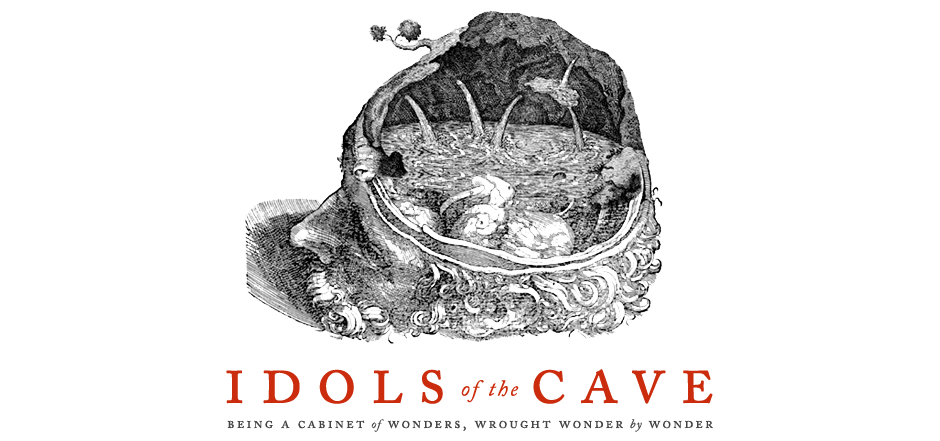
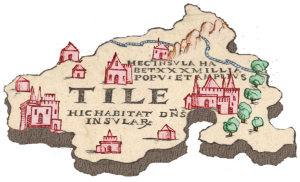
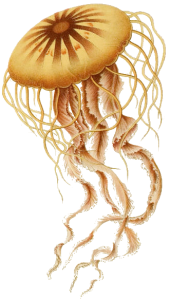
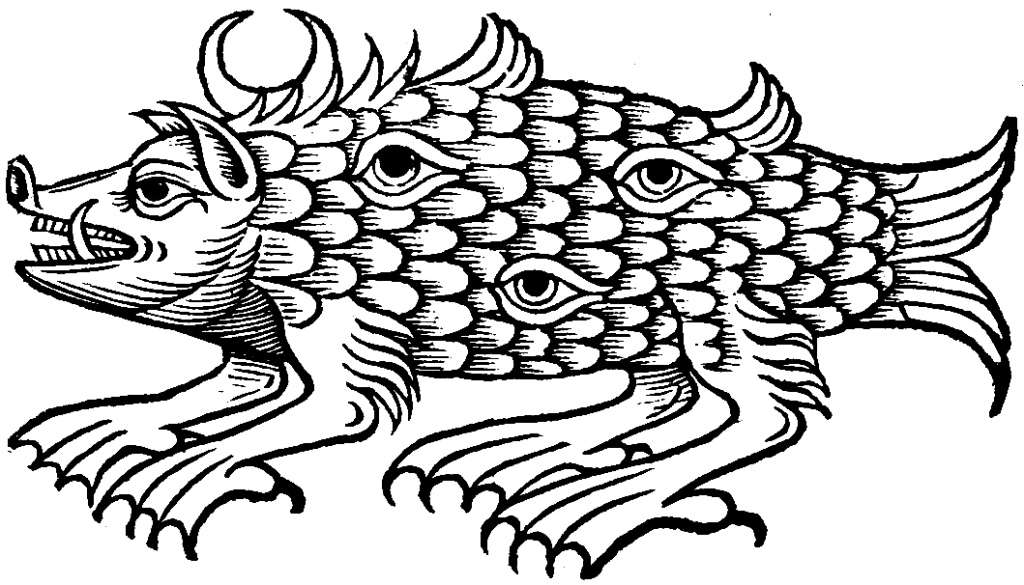

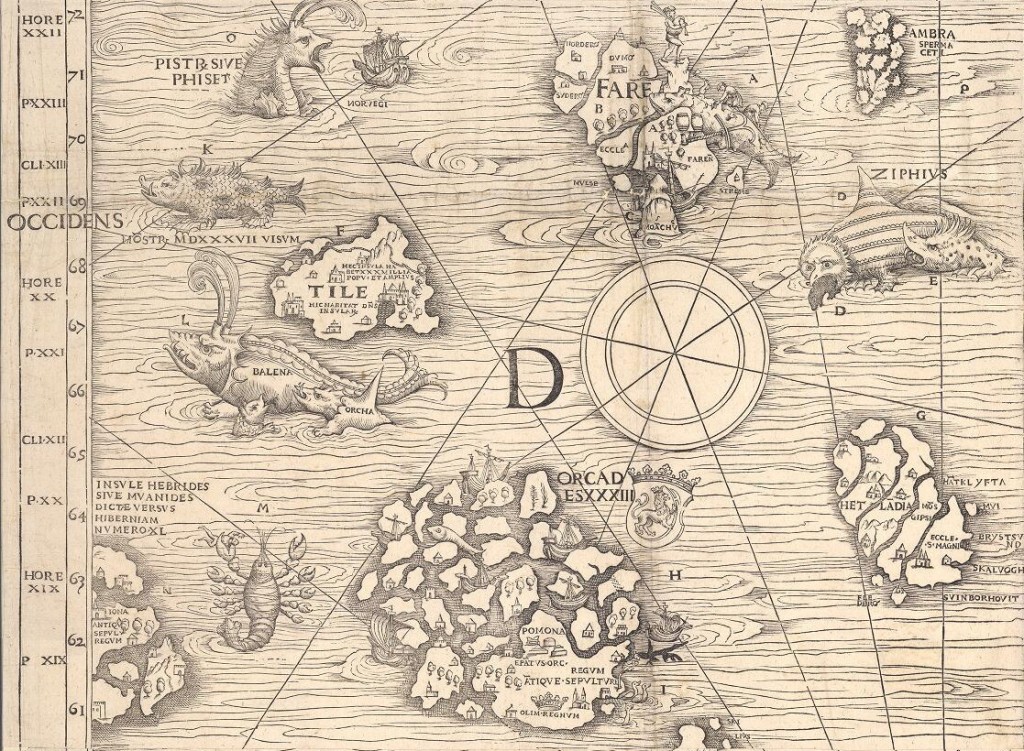
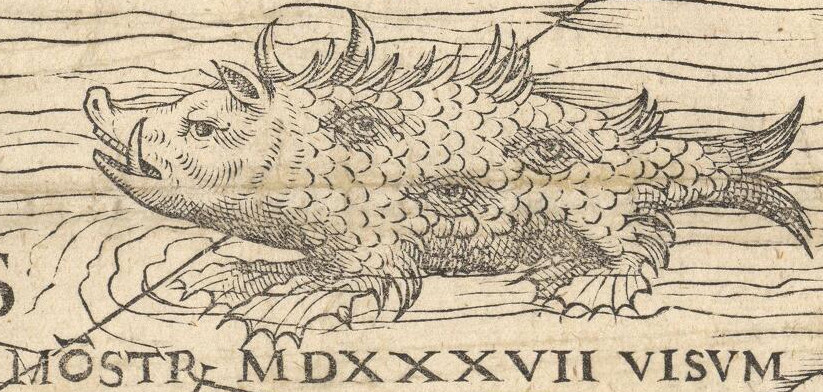
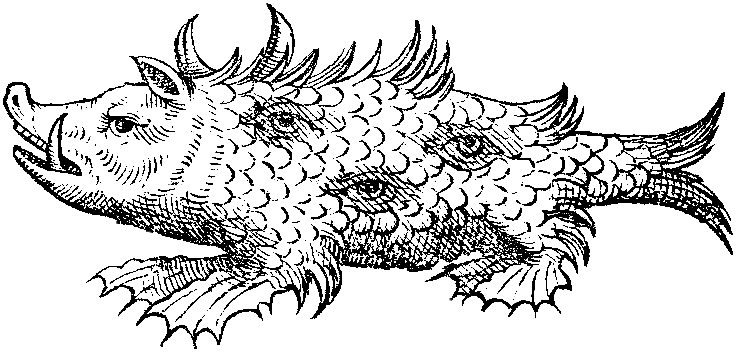


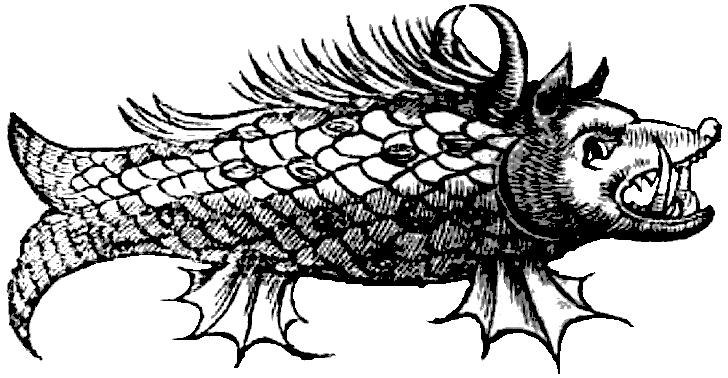
Pingback: Incredibili meraviglie al di là di Thule | Likely Classics
Pingback: Net of Wonders — mobtownblues
Pingback: The Slave Queens of Merovingian France – text and trowel